contributor
How to Get Rid of Water Bugs
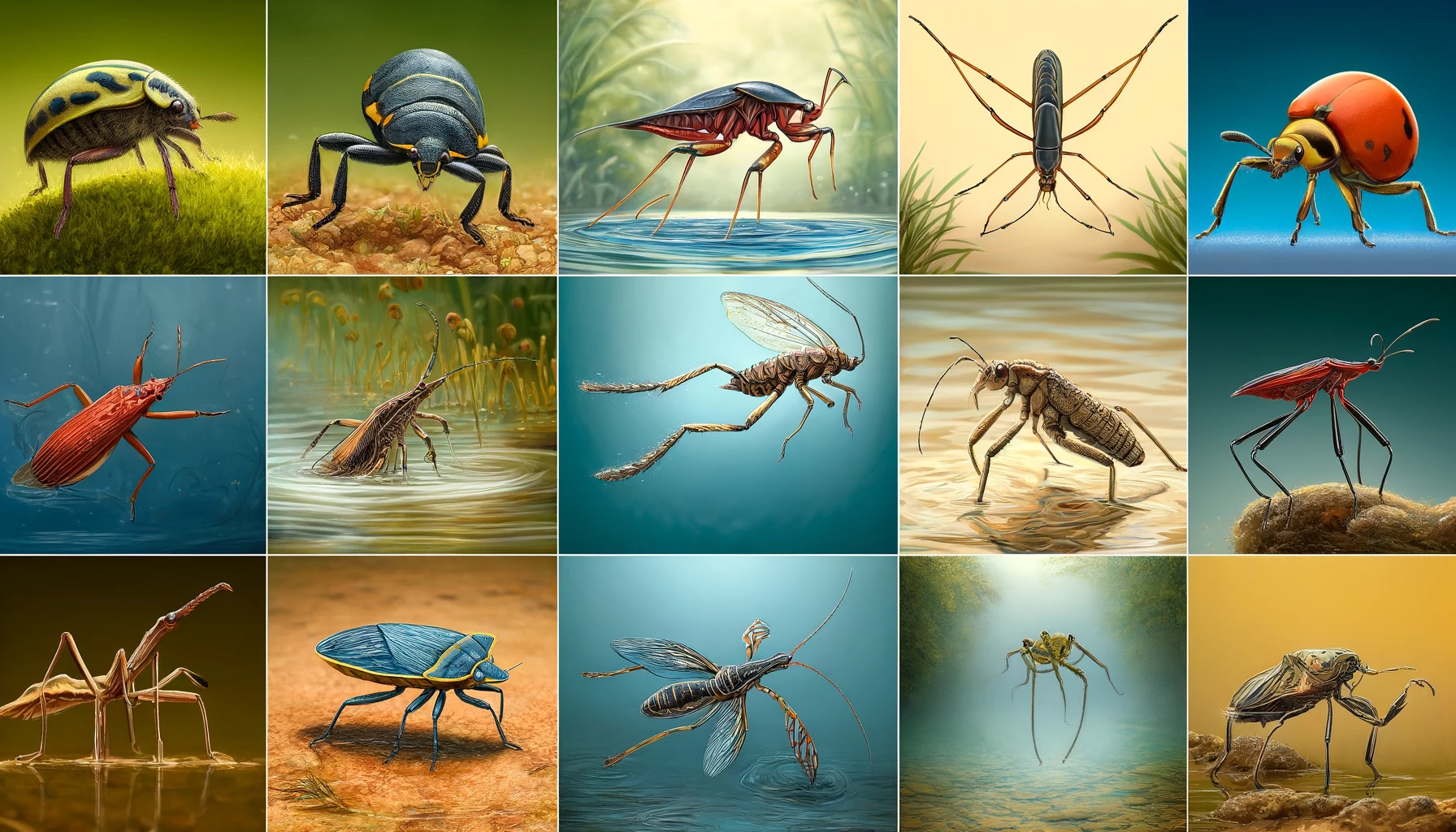 While the term “water bug” often brings to mind images of cockroaches, particularly the Oriental water cockroach, it actually encompasses a variety of aquatic insects that can invade our spaces. These creatures, ranging from the menacing giant water bug to the common backswimmer, can become nuisances in and around water bodies in our homes and gardens. In this guide, we’ll explore effective methods to manage these pests, ensuring your environment remains comfortable and bug-free.
While the term “water bug” often brings to mind images of cockroaches, particularly the Oriental water cockroach, it actually encompasses a variety of aquatic insects that can invade our spaces. These creatures, ranging from the menacing giant water bug to the common backswimmer, can become nuisances in and around water bodies in our homes and gardens. In this guide, we’ll explore effective methods to manage these pests, ensuring your environment remains comfortable and bug-free.
Understanding Water Bugs
Definition and Clarification of the Term “Water Bugs” Versus Cockroaches The term “water bug” is commonly used to refer to various types of insects that live in or near water. While Oriental cockroaches are often called water bugs due to their preference for damp environments, true water bugs belong to different insect families and have distinct characteristics.
Types of Common Water Bugs
-
- Giant Water Bugs (Belostomatidae): Large predatory insects that live in freshwater habitats.
- Water Striders (Gerridae): Insects known for their ability to walk on water surfaces.
- Backswimmers (Notonectidae): Insects that swim upside down and are often found in ponds and slow-moving waters.
- Water Boatmen (Corixidae): Insects that swim right-side up and are usually found in freshwater environments.
Identifying Water Bugs
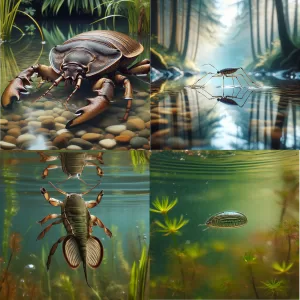
How to Recognize Different Water Bugs Based on Size, Shape, and Habitat
- Giant Water Bugs: Large, flat-bodied insects with grasping front legs and a penchant for preying on small aquatic animals.
- Water Striders: Long-legged insects that skate across the water’s surface, using surface tension to stay afloat.
- Backswimmers: Recognizable by their habit of swimming upside down and their oar-like hind legs.
- Water Boatmen: Smaller, oval-shaped insects that swim right-side up and are often found in freshwater habitats.
Photos or Illustrations for Visual Identification (Include high-quality images or illustrations of each type of water bug for easy identification.)
Common Habitats and Behavior
Description of Typical Environments Where Water Bugs Thrive Water bugs are typically found in or near water bodies such as ponds, lakes, streams, and slow-moving rivers. They are also commonly found in gardens with water features, swimming pools, and even inside homes where moisture is prevalent.
Behavior Patterns That Attract Them to Human Habitats Water bugs are attracted to areas with abundant moisture and food sources. Overgrown vegetation, stagnant water, and poorly maintained pools can create ideal conditions for these pests.
Preventive Measures
Strategies to Prevent Water Bugs from Settling in Your Environment
- Maintain Cleanliness: Regularly clean and maintain water features, pools, and ponds to prevent stagnation and overgrowth.
- Eliminate Standing Water: Ensure there are no areas with standing water around your home.
- Proper Drainage: Maintain proper drainage systems to prevent water accumulation.
Importance of Water Management and Cleanliness in Preventing Infestations Good water management practices and cleanliness are essential in preventing water bug infestations. Regular maintenance of water bodies and eliminating standing water can significantly reduce the likelihood of an infestation.
How to Get Rid of Water Bugs?
How to get rid of water roaches naturally
Use of Natural Repellents and Barriers
- Diatomaceous Earth: Sprinkle around areas where water bugs are commonly found. It dehydrates and kills insects upon contact.
- Essential Oils: Oils like eucalyptus, lavender, and peppermint can act as natural repellents when sprayed around water bug-prone areas.
Home Remedies That Are Safe and Effective
- Vinegar and Water Spray: A mixture of vinegar and water can be an effective natural deterrent when sprayed in affected areas.
- Boric Acid: Applying boric acid near water bug habitats can help control their population.
What kills water bugs instantly?
Chemical Controls
Recommended Insecticides and Their Safe Application
- Baits and Insecticides: Use products specifically designed for water bugs, following the manufacturer’s instructions for safe application.
- Surface Sprays: Apply insecticidal sprays around entry points and common hiding spots to eliminate water bugs.
When and How to Use Chemicals for Effective Control Chemicals should be used as a last resort when natural methods are ineffective. Apply insecticides in targeted areas where water bugs are active, and always follow safety guidelines to avoid harm to pets and humans.
Professional Pest Control Solutions
When to Call a Professional If your water bug infestation is severe or persistent, it may be time to call a professional pest control service. Professionals have the expertise and tools to handle large infestations effectively.
What to Expect from Professional Pest Control Services Professional pest control services will conduct a thorough inspection of your property, implement targeted treatments, and provide follow-up visits to ensure the infestation is fully resolved.
Maintenance and Monitoring
Regular Practices to Keep Your Area Water Bug-Free
- Regular Inspections: Routinely check water bodies and damp areas for signs of water bugs.
- Consistent Cleaning: Maintain cleanliness and proper water management practices to prevent re-infestation.
Tools and Techniques for Ongoing Monitoring
- Sticky Traps: Place sticky traps around potential entry points to monitor water bug activity.
- Periodic Treatments: Schedule regular pest control treatments if necessary to maintain a bug-free environment.
By understanding the types of water bugs, their habitats, and effective control measures, you can protect your home from these unwelcome pests. Consistency in preventive efforts and prompt action at the first sign of infestation are key to keeping your environment comfortable and bug-free.
Stay vigilant and proactive in managing water bugs. Act swiftly at the first signs of infestation, and don’t hesitate to consult professionals for severe situations to ensure your home remains pest-free.
Palmetto Bug (often mistaken for a water bug)
A palmetto bug is a common name for certain large cockroaches, particularly the American cockroach (Periplaneta americana), which are often found in the southeastern United States. The term “palmetto bug” is used because these cockroaches are frequently found in and around palmetto trees. While the name suggests a specific type of insect, it typically refers to any large cockroach seen in the region.
Palmetto Bug Characteristics
- Appearance: Palmetto bugs are usually reddish-brown with a yellowish figure-8 pattern on the back of their heads. They can grow up to 1.5 inches or longer.
- Habitat: These cockroaches thrive in warm, humid environments and are commonly found in basements, sewers, and other damp areas. They can also be found in homes, particularly in kitchens, bathrooms, and crawl spaces.
- Behavior: Palmetto bugs are nocturnal and will scatter when exposed to light. They can fly short distances, which can be startling to homeowners.
Relation to Water Bugs
- Misidentification: People often confuse palmetto bugs with other types of large, water-loving insects due to their size and the damp environments they inhabit.
- Overlap in Control Methods: Many of the preventive and control measures for water bugs, such as maintaining cleanliness, reducing moisture, and using insecticides, are also effective for controlling palmetto bugs.
How to Get Rid of Palmetto Bugs
- Sanitation: Keep your home clean, especially in the kitchen and bathroom areas. Avoid leaving food out and store food in sealed containers.
- Moisture Control: Fix leaky faucets and pipes, use dehumidifiers, and ensure proper ventilation to reduce humidity levels.
- Sealing Entry Points: Inspect your home for cracks and gaps, particularly around doors, windows, and the foundation. Seal these entry points to prevent palmetto bugs from entering.
- Bait and Insecticides: Use bait stations and insecticides designed for cockroach control. Place them in areas where palmetto bugs are likely to be active.
- Professional Pest Control: For severe infestations, professional pest control services may be necessary. They can provide thorough inspections and targeted treatments.
Understanding the distinctions between various pests, including water bugs and palmetto bugs, is essential for effective pest management and maintaining a comfortable living environment.
How Long Can a Cockroach Live Without Air?
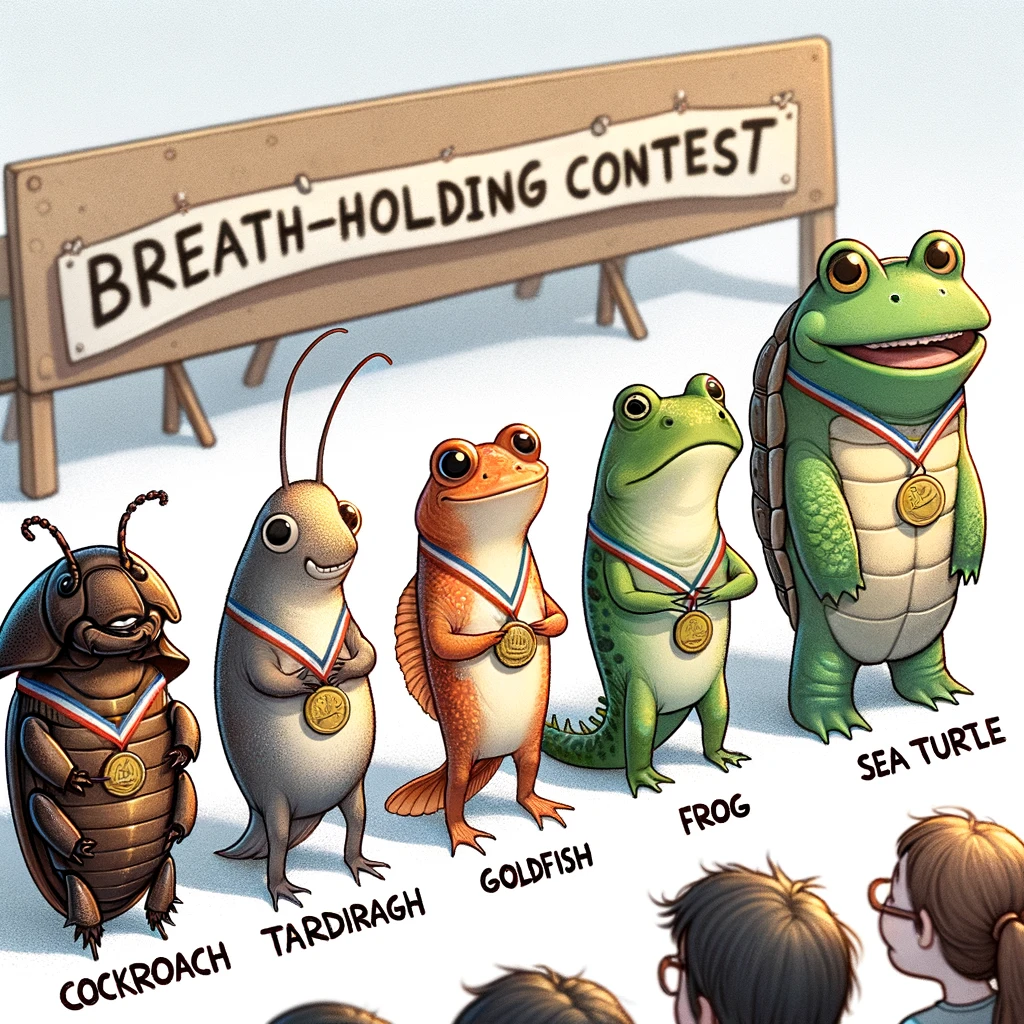 How Long Can a Cockroach Live Without Air?
How Long Can a Cockroach Live Without Air?
In the realm of urban legends and scientific marvels, the cockroach stands out for its incredible survival abilities. Among these, the cockroach’s capacity to survive without air for extended periods sparks both awe and curiosity. This post delves into the fascinating biology behind this resilience and what it means for the infamous pest’s survival in harsh conditions.
The Resilience of Cockroaches
Cockroaches are among the most ancient insects on Earth, having adapted to survive in a wide range of environments over millions of years. This adaptability includes an extraordinary tolerance for various extreme conditions, including a lack of oxygen.
Survival Without Air
Research has shown that cockroaches can survive without air for up to 40 minutes and recover fully once oxygen is reintroduced. This capability is far beyond that of humans and most other terrestrial life forms, making cockroaches particularly hardy survivors in environments where other creatures would quickly perish.
| Animal | Time Without Air |
|---|---|
| Cockroach | Up to 40 minutes |
| Tardigrade | More than 10 years in a dehydrated state |
| Goldfish | Several days under ice |
| Frog | Up to several hours |
| Sea Turtle | 4-7 hours underwater |
How Do They Do It?
Cockroaches have a highly efficient system for regulating oxygen and carbon dioxide levels, allowing them to shut down their metabolic processes and reduce their need for oxygen significantly. This system, coupled with their open circulatory system and the ability to absorb oxygen through their body segments, enables cockroaches to survive in low-oxygen environments.
Implications for Pest Control
The cockroach’s ability to survive without air poses challenges for pest control methods that rely on suffocation or fumigation. Understanding the biological resilience of cockroaches can help in developing more effective strategies to manage infestations, emphasizing the need for comprehensive approaches that address the cockroach’s various survival tactics.
Conclusion
The cockroach’s ability to live without air is just one of many testaments to its incredible resilience and adaptability. While often maligned as pests, cockroaches offer valuable insights into survival mechanisms and the potential for life to thrive in extreme conditions. However, when it comes to managing cockroach populations in human habitats, this resilience underscores the importance of employing strategic and effective pest control measures.
The Lifecycle of the German Cockroach: From Egg to Adult
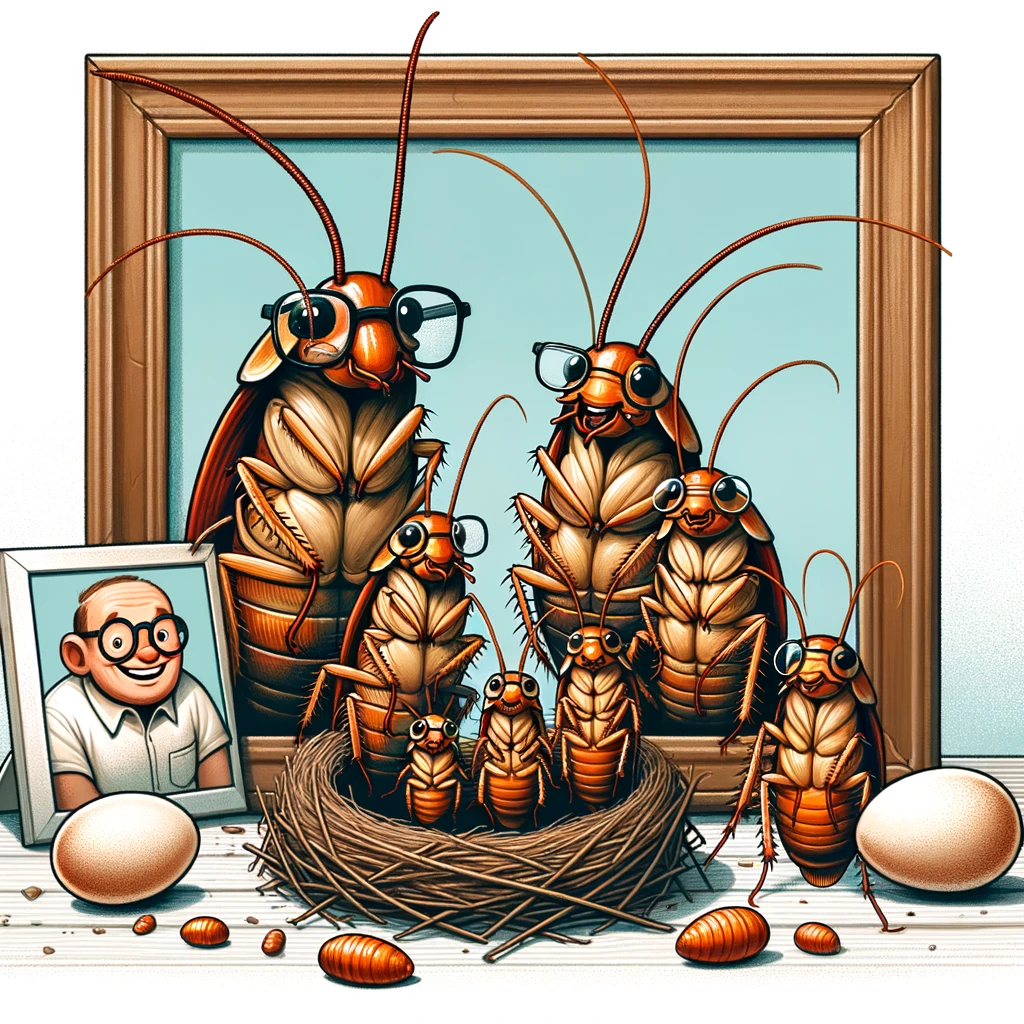 The Lifecycle of the German Cockroach: From Egg to Adult
The Lifecycle of the German Cockroach: From Egg to Adult
German cockroaches are among the most common and troublesome pests found in homes and businesses worldwide. Understanding their lifecycle is crucial for effective pest management. This post delves into the stages from egg to adult, highlighting the rapid reproduction rate and resilience of the German cockroach.
Egg Stage (Ootheca)
- Formation: Female German cockroaches produce an egg case known as an ootheca, containing up to 48 eggs.
- Incubation: The ootheca is carried by the female until the eggs are ready to hatch, typically within 28 days.
Nymph Stage
- Hatching: Nymphs emerge from the ootheca fully formed but miniature in size and lacking wings.
- Development: Nymphs undergo multiple molts, shedding their exoskeleton several times as they grow.
- Duration: This stage can last from several weeks to months, depending on environmental conditions.
Adult Stage
- Maturity: Nymphs mature into adults with fully developed wings, although German cockroaches rarely fly.
- Reproduction: Adults can reproduce soon after reaching maturity, with females producing multiple oothecae throughout their lifetime.
- Lifespan: Adult German cockroaches can live up to a year under optimal conditions, continuing the cycle of reproduction.
Control and Prevention
Understanding the rapid lifecycle of the German cockroach is key to controlling infestations:
- Sanitation: Reduce food and water sources to deter cockroach activity.
- Exclusion: Seal cracks and crevices to prevent entry and shelter.
- Monitoring: Use traps to assess and monitor cockroach populations.
- Professional Pest Control: For severe infestations, professional treatments may be necessary for effective eradication.
Conclusion
The lifecycle of the German cockroach underscores the importance of quick and comprehensive pest control measures. By targeting each stage of their lifecycle, homeowners and pest control professionals can implement strategies to manage and ultimately reduce cockroach populations effectively.
Do Mice Eat Roaches
 Do Mice Eat Roaches? Exploring the Dynamics Between Mice and Cockroaches
Do Mice Eat Roaches? Exploring the Dynamics Between Mice and Cockroaches
In the world of pests, the interactions between different species can be both fascinating and complex. A common question that arises is whether mice, known for their versatile diet, consume cockroaches. This blog post delves into the dynamics between mice and cockroaches, shedding light on their occasional encounters and what this means for pest control in your home.
The Opportunistic Diet of Mice
Mice are opportunistic feeders that adapt their diet based on the availability of food sources. Their diet typically includes seeds, grains, fruits, and even insects. In environments where these resources are scarce, mice may turn to alternative food sources, including cockroaches.
Interaction Between Mice and Cockroaches
When mice and cockroaches share the same habitat, especially in dark, cluttered, and unsanitary environments, there’s a higher chance of occasional interactions. These conditions provide ideal hiding spots and breeding grounds for both pests, increasing the likelihood of mice preying on cockroaches.
Factors Influencing Predatory Behavior
- Food Scarcity: In situations where traditional food sources are limited, mice are more likely to consume cockroaches.
- Environmental Conditions: Cluttered and unsanitary conditions can foster closer encounters between mice and cockroaches, leading to predatory behavior.
Implications for Pest Control
Understanding the relationship between mice and cockroaches can offer insights into integrated pest management strategies:
- Sanitation: Maintaining a clean and clutter-free environment reduces the appeal of your home to both mice and cockroaches.
- Exclusion: Sealing entry points and eliminating hiding spots can help prevent both pests from establishing a presence in your home.
- Monitoring: Regular inspections can help identify signs of infestation early, allowing for timely intervention.
Conclusion
While mice may occasionally eat cockroaches, relying on this natural interaction for pest control is not advisable due to the health risks and damage associated with both pests. Effective pest management involves a combination of sanitation, exclusion, and professional intervention when necessary. By understanding the dynamics between these pests, homeowners can take proactive steps to maintain a pest-free environment.
Wood Roach vs. Cockroach
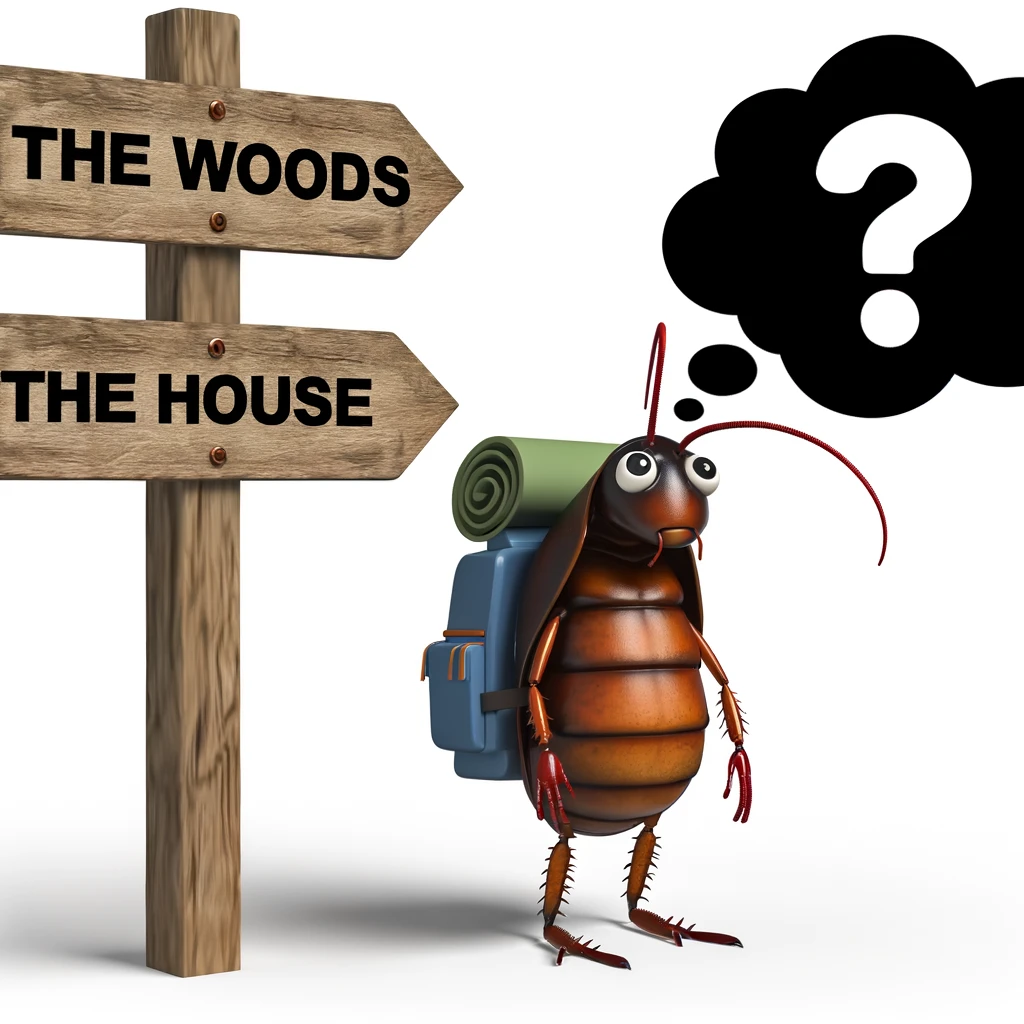 Wood Roach vs. Cockroach: Understanding the Differences
Wood Roach vs. Cockroach: Understanding the Differences
While all roaches might look similar at a glance, not all of them share the same habits or preferences. Wood roaches and common household cockroaches often get lumped together, but significant differences exist between them. This guide aims to clarify these differences, helping you identify and effectively deal with each type.
Key Differences Between Wood Roaches and Cockroaches
Appearance
- Wood Roaches: Generally, wood roaches are larger and have a more uniform brown color. Males have long, transparent wings, while females have shorter wings.
- Household Cockroaches: Common household species like the German cockroach or the American cockroach often have darker coloration and may exhibit varying sizes. Their wings are also more developed, enabling some species to fly.
Habitat
- Wood Roaches: True to their name, wood roaches prefer outdoor environments with plenty of decaying wood and leaf litter. They are less likely to infest indoor spaces but might wander in by mistake.
- Household Cockroaches: These pests thrive indoors, especially in areas with ample food, warmth, and moisture. Kitchens and bathrooms are common hotspots for these species.
Behavior
- Wood Roaches: Wood roaches are not attracted to the same food scraps as household cockroaches and are less likely to be found near human dwellings unless brought in accidentally with firewood or other outdoor items.
- Household Cockroaches: Highly adaptable, these cockroaches seek out human food, water sources, and shelter, making them more of a nuisance and health risk inside homes.
Managing Wood Roaches and Cockroaches
Wood Roaches
Since wood roaches prefer the outdoors, preventing them from entering your home is the best strategy. Keep firewood and debris away from your home’s foundation and seal any cracks or openings.
Household Cockroaches
Eradicating household cockroaches requires a multifaceted approach:
- Sanitation: Keep your home clean and free of food scraps.
- Exclusion: Seal cracks and entry points.
- Bait and Traps: Use baits and traps to reduce their numbers.
- Professional Help: For severe infestations, professional pest control may be necessary.
Conclusion
Understanding the differences between wood roaches and common household cockroaches is crucial for effective pest management. By identifying the type of cockroach you’re dealing with, you can implement targeted strategies to keep your home pest-free.
Cockroach Poop: A Telltale Sign of Infestation
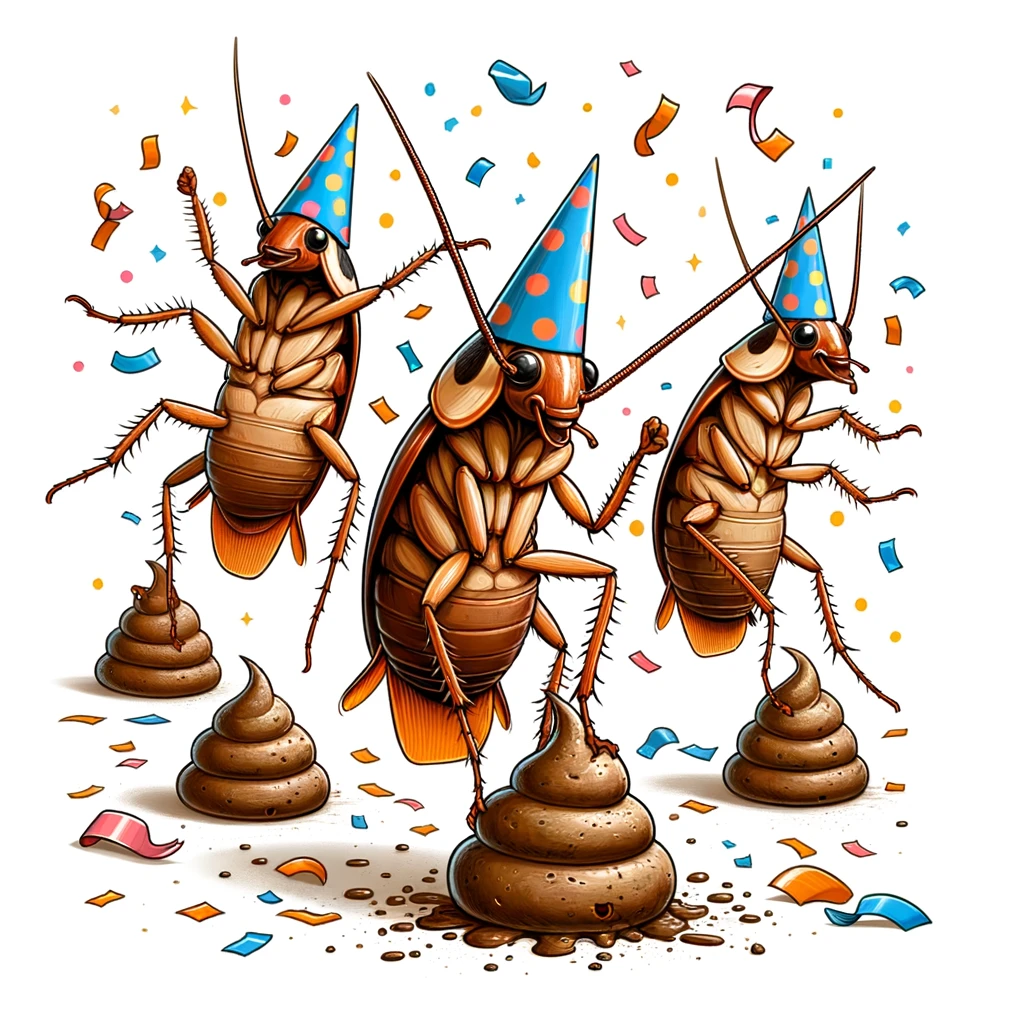 Cockroach Poop: A Telltale Sign of Infestation
Cockroach Poop: A Telltale Sign of Infestation
Discovering cockroach poop in your home is a clear indicator of an unwelcome cockroach presence. These pests are not just a nuisance but also pose health risks by spreading bacteria and triggering allergies. Understanding the appearance and common locations of cockroach droppings can help you identify an infestation early and take necessary action. This guide provides essential insights into recognizing cockroach poop and effectively addressing the underlying infestation.
Identifying Cockroach Poop
Cockroach droppings are distinct in appearance, varying slightly among different species. Generally, these droppings are small, dark, and cylindrical, often resembling black pepper or coffee grounds. The size and shape can provide clues about the type of cockroach inhabiting your space.
Characteristics of Cockroach Droppings
- Size: Ranges from very small specks to larger droppings, depending on the cockroach species.
- Color: Typically black or dark brown.
- Shape: Cylindrical, with blunt ends; larger species may produce ridged droppings.
Common Locations for Cockroach Droppings
Cockroaches prefer dark, moist environments close to food sources. Their droppings are often found in:
- Kitchen Cabinets: Check corners, shelves, and under the sink.
- Appliances: Behind and beneath refrigerators, stoves, and dishwashers.
- Storage Areas: In closets, basements, and attics where boxes and clutter provide hiding spots.
Health Risks Associated with Cockroach Droppings
Cockroach droppings can contribute to health problems, including:
- Allergies and Asthma: The allergens in cockroach droppings can trigger asthma attacks and allergic reactions.
- Disease Transmission: Cockroaches can spread bacteria like Salmonella through their droppings, contaminating food surfaces and utensils.
Addressing Cockroach Infestations
If you find cockroach poop in your home, it’s crucial to act quickly to eliminate the infestation:
- Clean Up: Safely clean the affected areas, wearing gloves and using a vacuum with a HEPA filter to remove droppings.
- Eliminate Food Sources: Store food in sealed containers and keep your kitchen clean.
- Seal Entry Points: Fill cracks and gaps in walls, floors, and around windows and doors.
- Professional Pest Control: For severe infestations, consider hiring a pest control professional to apply safe and effective treatments.
Conclusion
Recognizing the signs of cockroach poop is key to early infestation detection. By understanding where to look and what to look for, you can take proactive steps to maintain a healthy and cockroach-free home. Regular cleaning, proper food storage, and sealing entry points are essential practices to prevent cockroach infestations.
Call to Action
Have you encountered cockroach droppings in your home? Share your experiences and tips for dealing with infestations in the comments below.
Are Roaches Cannibals?
 Unveiling the Cannibalistic Behavior of Cockroaches
Unveiling the Cannibalistic Behavior of Cockroaches
Cockroaches are known for their resilience and adaptability, traits that have enabled them to survive through centuries. However, one lesser-known aspect of their behavior is cannibalism. Yes, when faced with limited resources, cockroaches can exhibit cannibalistic tendencies, consuming dead or injured members of their own species. This post delves into the reasons behind this behavior and what it means for controlling cockroach populations.
Understanding Cockroach Cannibalism
Cockroach cannibalism is primarily driven by the need for nutrition and the competition for resources. In environments where food is scarce, cockroaches may turn to cannibalism as a means of survival.
Why Do Cockroaches Resort to Cannibalism?
- Nutritional Needs: Cockroaches require protein and moisture to thrive, which can be found in their deceased or weakened counterparts.
- Population Control: Cannibalism helps regulate the population density, ensuring that only the strongest and healthiest individuals survive.
- Territorial Behavior: It can also be a form of territorial behavior, eliminating competition and reducing the number of mouths to feed.
Implications for Pest Control
Understanding the cannibalistic behavior of cockroaches has implications for pest control strategies.
- Baiting Techniques: Knowing that cockroaches can resort to cannibalism, pest control efforts can leverage this behavior through baiting techniques. Infected cockroaches can spread poison back to their hiding spots, affecting others that may consume them.
- Population Management: Recognizing signs of cannibalism can indicate high population densities and stress within a cockroach community, signaling the need for more aggressive control measures.
Ethological Insights
The cannibalistic behavior of cockroaches offers fascinating insights into their social structure and survival strategies. It highlights the complexity of cockroach societies and their adaptability to challenging environments.
Conclusion
While the idea of cockroach cannibalism may be unsettling, it is a testament to the survival capabilities of these pervasive pests. Understanding this aspect of cockroach behavior not only adds to our knowledge of their ecological roles but also aids in developing more effective pest control methods. It’s a reminder of the intricate balance within ecosystems and the lengths to which organisms will go to survive.
Cockroach in Your Fridge
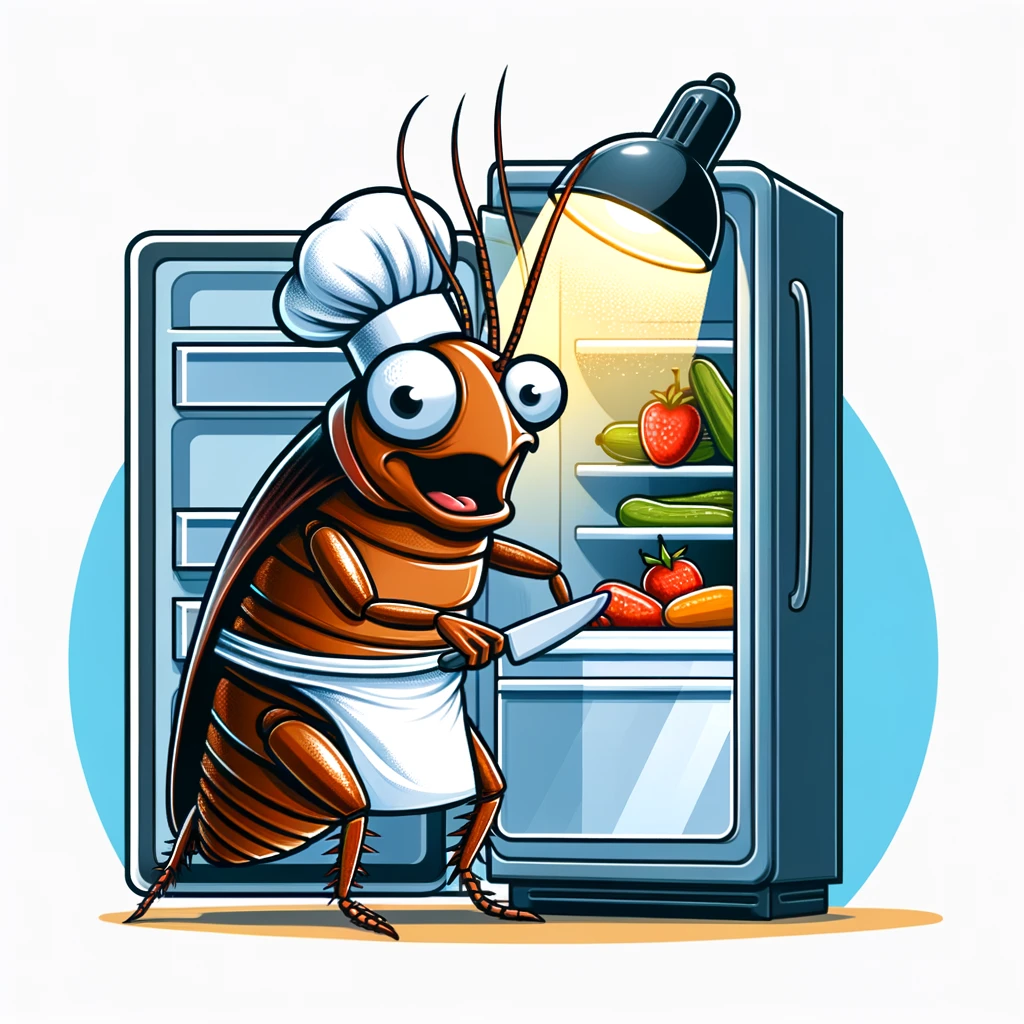 Dealing with Cockroaches in Your Fridge
Dealing with Cockroaches in Your Fridge
Discovering cockroaches in your fridge is not just unsettling; it poses health risks by contaminating your food. This guide provides a step-by-step approach to assess the infestation, clean your fridge thoroughly, eliminate the pests, and safeguard your kitchen against future invasions.
Step 1: Assess the Infestation
Begin by determining the extent of the infestation. Cockroaches in your fridge often indicate a larger problem in your home, as these pests typically seek water and food elsewhere.
Step 2: Deep Clean Your Fridge
- Empty the Fridge: Remove all food items and inspect them for signs of contamination.
- Clean Thoroughly: Use a solution of warm water and vinegar to clean the interior surfaces. Don’t forget the seals and crevices where cockroaches might hide.
- Dispose of Contaminated Food: Any food that’s been exposed to cockroaches should be discarded to prevent health risks.
Step 3: Eliminate the Pests
- Use Baits and Traps: Place cockroach baits and traps around your kitchen, focusing on areas near the fridge.
- Seal Entry Points: Cockroaches can enter through tiny spaces. Seal gaps around your home, especially where pipes and wires enter.
Step 4: Safeguard Against Future Infestations
- Regular Cleaning: Keep your kitchen and fridge clean to make them less attractive to cockroaches.
- Proper Food Storage: Store food in sealed containers to prevent cockroach access.
- Monitor Regularly: Check your fridge and kitchen periodically for signs of cockroach activity.
Conclusion
Dealing with cockroaches in your fridge requires a thorough approach to eliminate the current infestation and prevent future ones. By maintaining cleanliness, sealing entry points, and using appropriate pest control measures, you can keep your fridge and home cockroach-free.
Do Cats Eat Cockroaches?
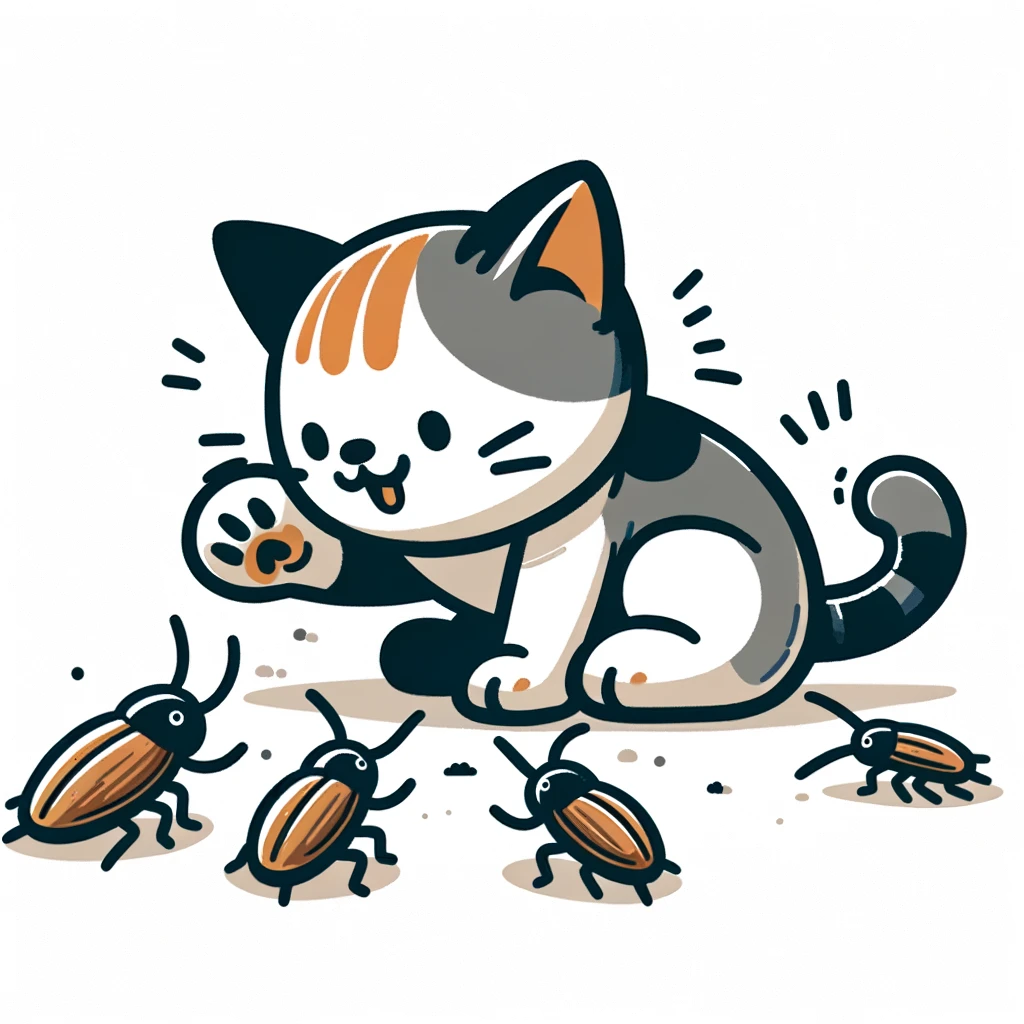 In the never-ending quest for effective pest control solutions, pet owners often wonder about the role their feline friends might play. Specifically, the question arises: ‘do cats eat cockroaches?’ This blog post dives into the fascinating dynamics between cats and these notorious household pests.
In the never-ending quest for effective pest control solutions, pet owners often wonder about the role their feline friends might play. Specifically, the question arises: ‘do cats eat cockroaches?’ This blog post dives into the fascinating dynamics between cats and these notorious household pests.
The Hunter Instinct in Cats
Cats are natural hunters, a trait inherited from their wild ancestors. This instinct drives them to stalk, chase, and pounce on various small creatures, including insects. Cockroaches, with their quick movements and tendency to invade our living spaces, often become unintended targets of this predatory behavior.
Do Cats Eat Cockroaches?
Yes, cats do eat cockroaches. While not all cats will consume their prey, many will catch and kill cockroaches as part of their instinctual hunting behavior. Some cats may play with the insects, while others might indeed eat them. This can vary greatly depending on the individual cat’s personality, hunger level, and previous experiences.
The Pros and Cons
Benefits of Cats Hunting Cockroaches
- Natural Pest Control: Cats can help reduce cockroach populations in your home through their hunting activities.
- Entertainment: Watching their prey provides mental stimulation and physical exercise for cats.
Risks and Considerations
- Health Concerns: Cockroaches carry pathogens that could potentially harm your cat if ingested. Additionally, cockroaches exposed to insecticides pose a poisoning risk.
- Incomplete Solution: While cats may catch some cockroaches, they are unlikely to eliminate an infestation. Professional pest control methods are more reliable for long-term solutions.
Encouraging Safe Interactions
To ensure the safety of your feline hunter and effectiveness in pest control, consider the following tips:
- Regular Vet Checkups: Keep your cat healthy with routine veterinary care, especially if they are known to hunt and eat insects.
- Pest Control Safety: Opt for pet-safe pest control solutions to minimize health risks to your cat.
Conclusion
While cats may indeed eat cockroaches, relying solely on your feline friend for pest control is not advisable. Cats can offer a helping paw in reducing the visibility of cockroach problems, but addressing an infestation requires a more comprehensive approach. Remember to prioritize your cat’s health and well-being in your pest management strategies.
Nature’s Pest Control: What Eats Cockroaches?
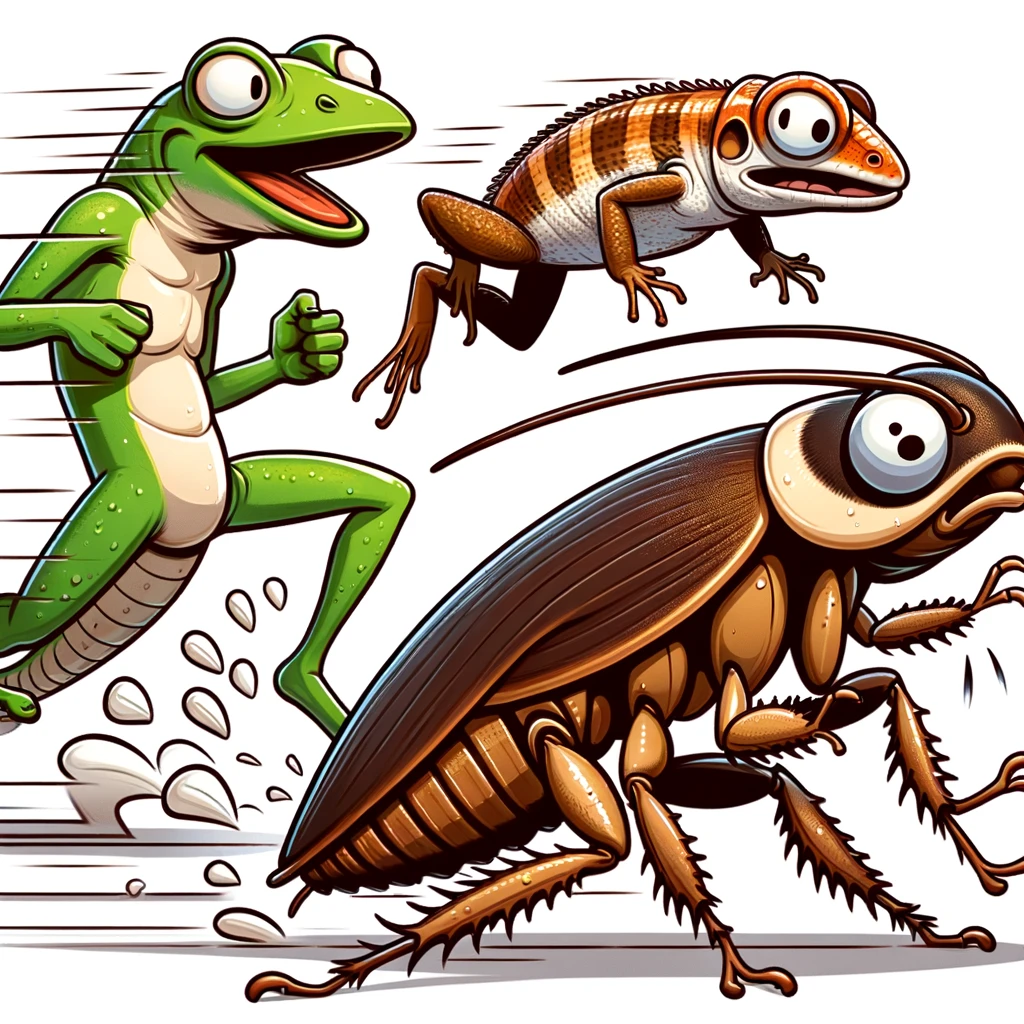 A Guide to Leveraging Natural Predators for Cockroach Management
A Guide to Leveraging Natural Predators for Cockroach Management
In the battle against cockroach infestations, understanding the natural ecosystem can provide effective strategies for pest control. Numerous predators feast on cockroaches, playing a crucial role in managing their populations. What eats cockroaches? This guide explores the natural enemies of cockroaches and how leveraging these predators can contribute to cockroach management and ecosystem balance.
Nature’s Pest Control: What Eats Cockroaches?
Cockroaches, despite their notorious resilience, fall prey to various predators in the wild. Here’s a look at some of nature’s most efficient cockroach hunters:
Insect Predators
- Spiders: Many spider species are adept at capturing and consuming cockroaches.
- Centipedes: These arthropods are nocturnal hunters that can take down larger prey, including cockroaches.
- Praying Mantises: Known for their predatory efficiency, praying mantises can prey on cockroaches among other insects.
Reptiles and Amphibians
- Lizards: Geckos and other small lizards frequently eat cockroaches, making them natural allies in pest control.
- Frogs and Toads: These amphibians consume a wide range of insects, including cockroaches, especially in garden and outdoor settings.
Birds
Various bird species, especially those that forage on the ground or in urban settings, may include cockroaches in their diet.
Mammals
- Rodents: Mice and rats, although not ideal to encourage due to their own pest status, sometimes eat cockroaches.
- Bats: In areas where bats are prevalent, they can help control outdoor cockroach populations.
Leveraging Natural Predators for Cockroach Management
Incorporating natural predators into your pest control strategy requires a balanced approach, ensuring that you do not introduce new pest problems. Here are some environmentally friendly ways to leverage nature’s pest control:
- Encourage Beneficial Insects: Maintaining a garden that attracts predatory insects like praying mantises and spiders can help control cockroach populations outdoors.
- Attract Birds: Bird feeders and baths can attract insectivorous birds that feed on cockroaches.
- Foster a Healthy Ecosystem: A biodiverse environment naturally regulates pest populations, including cockroaches, through the action of predators.
Ecosystem Balance and Cockroach Predators
Knowing what eats cockroaches and relying on natural predators to control cockroach populations highlights the importance of ecological balance. By understanding and supporting the roles of these predators, we can develop more sustainable approaches to pest management that minimize the need for chemical interventions.
Conclusion
While cockroaches have adapted to survive in various environments alongside humans, their natural predators play a critical role in keeping their populations in check. By fostering environments that support these predators, we can leverage nature’s own mechanisms for pest control, contributing to a healthier, more balanced ecosystem.
- The Life Span of a Cockroach
- Do Cockroaches Eat Clothes?
- Do Cockroaches Have Teeth?
- Shrimps and Cockroaches
- Will Sleeping with the Light On Keep Cockroaches Away?
- How to get roaches out of your car overnight
- Do Cockroaches Feel Pain?
- How Many Legs Do Cockroaches Have?
- Comparing Cockroach Eggs Size for Different Types of Cockroaches
- Identifying a Cockroach Bite on the Lips or Face
- Black Water Bug Identification and Control
- Why Do Water Bugs Come Out At Night?
- What Does Roach Rash Look Like?
- Can Cockroaches Bite Your Eyelid?
- Can Cockroaches Live in Your Balls?
- How did cockroaches get their name?
- Why Do Cockroaches Shed Their Skin?
- What Smell do Palmetto Bugs Hate?
- Baby Palmetto Bug: Identification and Control
- Cockroach Eggs vs Poop: How to Tell the Difference
- How to Get Rid of Water Bugs
- How Long Can a Cockroach Live Without Air?
- The Lifecycle of the German Cockroach: From Egg to Adult
- Do Mice Eat Roaches
- Wood Roach vs. Cockroach